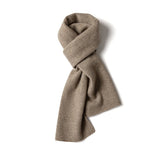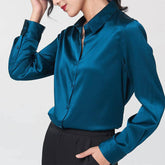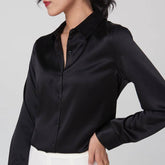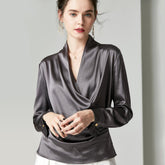Kimono vs. Robe

A kimono is a traditional Japanese garment known for its intricate designs and historical significance. In contrast, a robe is a more general term for various loose-fitting garments worn for comfort and style. Notably, the main difference between a kimono robe and a robe lies in their cultural origins and traditional usage.
Slipintosoft offers premium silk loungewear and sleepwear, and we want to give you a full comparative analysis of silk robes vs. Japanese kimonos. This article dives into the unique characteristics of both garments, exploring their history, design, cultural significance, and modern adaptations.
Key Takeaways
- A kimono is a traditional Japanese garment, while a robe is loose-fitting attire found in various cultures.
- Kimono robes feature unique designs and are often secured with an obi, while robes typically have a simpler construction.
- Cultural significance varies greatly; kimonos are tied to Japanese customs, whereas robes serve more casual purposes.
- Both garments have evolved over time, with modern adaptations reflecting current fashion trends.
- When choosing between the two, consider the occasion and desired level of formality.
Japanese Kimonos vs. Robes: Overview
|
Aspect |
Kimono Robe |
Robe |
|
Definition |
Traditional Japanese garment with a T-shaped, ankle-length design, secured by an obi sash |
Loose-fitting garment for comfort, featuring a relaxed fit with ties or belts |
|
Fabric |
Often silk or satin with intricate Japanese patterns |
Cotton, terry cloth, or satin, chosen for specific uses |
|
Cultural Roots |
Originated in Japan’s Heian period, symbolizing Japanese heritage |
Worn across cultures, adapted for everyday or ceremonial use |
|
Design |
Wrap-around with wide sleeves; ankle or floor-length |
Relaxed fit with waist ties; lengths vary |
|
Modern Use |
Styled as loungewear or outerwear, blending tradition with modern fashion |
Used as bathrobes, bridal party wear, or casual loungewear |
What is a Kimono Robe?


A kimono robe features a T-shaped silhouette, long sleeves, and is typically ankle-length. The kimono is secured with a wide sash known as an obi, which adds to its elegance. It is a traditional Japanese garment characterized by its unique design and cultural significance.
Traditionally made from luxurious fabrics such as silk or satin, the kimono robe is often decorated with intricate patterns that reflect Japanese artistry and seasonal themes. While kimonos were once worn daily, they are now primarily reserved for special occasions, representing Japan's rich history and cultural heritage.
Historical Background
The kimono robe has its roots deeply embedded in Japanese culture, dating back to the Heian period (AD 794 to 1185). Originally designed as formal attire for the aristocracy, the Japanese kimono has evolved into a symbol of Japanese identity and craftsmanship. A traditional kimono is characterized by its elaborate patterns and vibrant colors, frequently reflecting seasonal themes or personal status. Over the centuries, talented artisans have preserved the handcrafted techniques that make each piece unique.
During the Edo period (AD 1603 to 1867), kimonos became more accessible to the general public, leading to various styles and uses. Today, kimono robes are often worn for special occasions such as weddings or festivals, showcasing the rich history and cultural heritage that inspired their design.
Design Characteristics
The artistry involved in creating a kimono dress garment includes intricate dyeing techniques and detailed stitching, making each kimono robe a true work of art. Kimono robes are known for their distinctive silhouette. They typically feature wide sleeves and a wrap-around design that is secured with an obi — a decorative sash that adds elegance to the overall look. The length of a traditional kimono robe can vary from ankle-length to floor-length, depending on the style and occasion.
Modern Adaptations
Modern kimono robes may incorporate contemporary fabrics like satin or cotton, offering versatility while maintaining traditional elements. However, in recent years, the silk kimono robe has seen a resurgence in popularity as designers incorporate its elements into contemporary fashion. Modern kimono robes may feature shorter lengths or be styled as loungewear or bathrobe pieces suitable for casual outings or home relaxation.
Fashion brands are increasingly blending traditional silhouettes with modern aesthetics — think beautiful floral kimono robes that can be paired with jeans or worn over dresses. This fusion allows people to embrace traditional Japanese kimono culture while enjoying versatile styling options suited to today’s lifestyle.
What is a Robe?


A robe is a loose-fitting garment that serves various purposes across different cultures. Usually characterized by their relaxed fit and simple design, robes can be made from a variety of materials including cotton, terry cloth, and satin. They are often worn for comfort at home, such as bathrobes used after bathing or as dressing gowns for a day of relaxation.
Robes can feature ties or belts around the waist to secure them, which makes them easier to wear. Their flexibility means robes can transition from casual loungewear to stylish outerwear, appealing to a broad audience seeking comfort without sacrificing style.
Historical Background
The term “robe” covers a wide range of loose-fitting garments found across various cultures. Historically, robes have been worn by both men and women for comfort and practicality. In Western contexts, robes date back to ancient civilizations, where they were used as everyday attire or ceremonial garments.
Over time, different types of robes emerged, such as bathrobes for relaxation after bathing or dressing gowns for leisurely wear at home. Each type has its own unique characteristics but generally shares common features like ease of movement and comfort.
Design Characteristics
Robes are often characterized by their relaxed fit and simple construction. They typically feature long sleeves and may be designed with ties or belts around the waist for closure. The silhouette can vary widely, from ankle-length bathrobes to shorter dressing gowns meant for lounging at home.
Materials used in making robes range from plush terry cloth to lightweight cotton or luxurious satin. This variety allows consumers to choose based on personal preference: something cozy to wear after a shower or something elegant for evening wear.
Modern Adaptations
In contemporary fashion, robes have evolved beyond simple at-home wear into stylish loungewear options that can be worn outside the house. Designers now offer an array of styles — from chic satin robes perfect for bridal parties to cozy cotton options ideal for everyday wear.
The blending of traditional elements with modern designs has led to innovative interpretations of classic silhouettes — think kaftans inspired by global styles that retain the comfort associated with traditional robes while appealing to current fashion trends.
Slipintosoft: Luxurious Silk Robes and Dressing Gowns
Understanding the differences between a kimono robe and a standard robe deepens our appreciation of these beautiful garments. Whether you choose a luxurious silk robe from Slipintosoft or decide to go for a Japanese kimono robe for something traditional, browse our collection to browse your options!
Explore our silk robes for women and men today and embrace the elegance that these timeless pieces bring to your wardrobe!
Kimono vs. Robe FAQs
Is a kimono a robe?
Traditional Japanese kimonos are distinct from robes, as they are cultural garments with specific styling and historical significance, while robes are more loosely defined as garments for comfort. However, modern women’s kimono robes often blend the elegance of a kimono with the practicality of a robe, creating a versatile style.
Are robes and bathrobes the same?
No, robes are available in a variety of styles, including bathrobes, which are specifically designed for after-bath use with absorbent materials like cotton. Other types, such as bridal party robes or wrap-around robes, are perfect for lounging or special occasions and may differ in fabric and design from bathrobes.
What are the rules for wearing a kimono?
When wearing a kimono, especially a cotton kimono or yukata, you should wrap it left over right, as the opposite signifies mourning attire in Japanese culture. Kimono robes are a culmination of cultural elements and should be worn with respect, so it’s essential to follow traditional practices when styling a favorite kimono.
Back to top: Kimono vs. Robe










